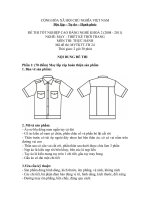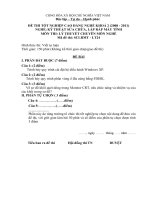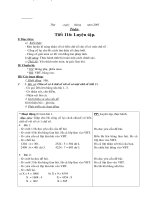Experiiment 24 calorimetry (2)
Bạn đang xem bản rút gọn của tài liệu. Xem và tải ngay bản đầy đủ của tài liệu tại đây (362.02 KB, 14 trang )
Name: Ngo Dang Quang Hieu
Trieu Vinh Khang
Dinh Xuan Phuoc
Duong Khac Trieu
22125084
22125112
22125226
22125333
Experiment 25 Report Sheet
Calorimetry
B. Enthalpy (Heat) of Neutralization for Acid-Base Reaction
HCl + NaOH
1. Volume of Acid (mL)
2. Temperature of acid (oC)
3. Volume of NaOH (mL)
4. Temperature of NaOH (oC)
Trial 1
50.00
32.00
50.00
32.50
5. Exact molar concentration of NaOH (mol/L)
6. Maximum temperature from graph (oC)
Trial 2
50.00
32.00
50.00
33.00
0.05
39.0
39.0
Calculations for Enthalpy (Heat) of Neutralization for an Acid – Base Reaction
1. Average initial temperature of acid and NaOH (oC)
32.75
33.5
5.75
5.5
2. Temperature change, ΔT (oC)T (oC)
3. Volume of final mixture (mL)
100
100
4. Mass of final mixture (g) (Assume the density of the
100
100
solution is 1.0 g/mL)
5. Specific heat of mixture
4.18 J/g• oC
6. Heat evolved (J)
-0.2403
-0.2299
7. Moles of OH- reacted, the limiting reactant (mol)
0.05
0.05
8. Moles of H2O formed (mol)
0.05
0.05
-2403 kJ/mole
-2299 kJ/mole
9. ΔT (oC)Hn (kJ/mol H2O), equation 25.8
-2351 kJ/mole
10. Average ΔT (oC)Hn (kJ/mol H2O)
Calculations for Trial 1:
Show calculations for Trial 1 using the correct number of significant figures
△ T =T final −T initial =38.5−3 2 . 75=5.75 oCV final =V HCl + V NaOH =50+ 50=100 mL
m final=V final x Density=100 ( mL ) x 1
Heat evolved=m final x 4.18
Moles of OH
( mLg )=100 g=0.01 kg
( Jg •° C ) x △ T =0.01 x 4.18 x 5.75=−0.24 ( J )
−¿reacted= Extractmolar concentration of NaOH x V NaOH =1
( molL ) x50 x 10
−3
( L ) =0.05 mol¿
1
△ H n=−specific heat ( H 2 O ) x combined massse sacid +base x △ T =−4.18 x 100 x 5.75=−2403
Average △ H n=
kJ
( mol
)
△ H ntrial 1+ △ H n trial 2
kJ
=−2403
2
mol
2
Trial
Trial
1
2
Temp Temp
36.0
36.0
The5stemperature
change
in theinfirst
Temperature
change
theminute
following
39.5
10s
39
15s
38.5
20s
38
37.5
137
minute
38.0
38.0
38.5
38.0
39.1
39
39.0
38.5
25s
38.939.0
39.0
30s
38.839.0
39.0
Temperature (oC)
Temperature (oC)
Time
38.739.0
39.0
39.0
39.0
39.0
39.0
36.5
35s
36
40s
35.5
45s
35
50s
38.5
39.0
39.0
55s
10
38.439.0
15
20
39.0
25
60s
38.339.0
39.0 Time (second)
39.0
34.5
5
15s
2
minutes
3
minutes
4
minutes
5
minutes
6
minutes
30s
38.6
39.0
38.2
30
35
40
45
50
55
5 minutes
60
Trial
Trial120
2 135 150 165 180 195 210 225 240 255 270 285 300
39.0
39.0
15 30 45
60 175 90 105
45s
39.0
39.0
60s
39.0
39.0
75s
39.0
39.0
90s
39.0
39.0
105s
39.0
39.0
120s
39.0
39.0
135s
39.0
39.0
150s
39.0
39.0
165s
39.0
39.0
180s
39.0
39.0
195s
39.0
39.0
210s
39.0
39.0
225s
39.0
38.5
240s
39.0
38.5
255s
38.5
38.5
270s
38.5
38.5
285s
38.5
38.5
300s
38.5
38.5
Time (second)
Trial 1
Trial 2
3
C. Enthalpy (Heat) of Solution for the Dissolution of a Salt
NH4Cl
Trial 1
Trial 2
1. Mass of salt (g)
5.000
5.000
2. Moles of salt (mol))
0.093
0.093
3. Mass of calorimeter (g)
207.470
207.440
4. Mass of calorimeter + water (g)
225.280
226.310
5. Mass of water (g)
18.810
18.870
32.000
33.000
o
6. Initial temperature of water ( C)
7. Final temperature of mixture from
25.000
24.000
graph (oC)
Calculations for Enthalpy (Heat) of Solution for the dissolution of Salt
1.Change in temperature of solution, △T
(℃))
2. Heat change of water (J)
-7
-9
550.90
710.56
3.Heat change of salt (J)
54.95
70.65
4.Total enthalpy change, equation 25.11
-1141.76
-1470.23
5.△Hs (J/mol salt) equation 25.12
-6514.51
-8401.07
6.Average △Hs (J/mol salt)
Name of salt:
Ammonium chloride
-7457.79
NH4Cl
Show calculations for Trial 1 using the correct number of significant figures
△ T =T final −T initial =25.00−3 2.00=−7 ° C
Heat change of water ( J )=−specific heat ( H 2 O ) x Mass of Water x △ T
J
x 18.81 ( g ) x (−7 ° C )=550.90 ( J )
g •° C
Heat change of salt ( J )=−specific heat ( H 2 O ) x Mass of Salt x △ T
¿−4.184
¿−1.57
J
x 5 ( g ) x (−7 ° C )=54.95 ( J )
g •° C
Total enthalpy change=−H eat change ( H 2 O )+
△Hs
(
−enenergy change salt
−54.95
=−550.90+
=−1141.76
Molesalt
0.093
(−energy chang e H O ) + (−energy chang e salt ) (−550.90+ (−54.95 ) )
J
J
=
=
=−6514.51
mol salt
mol e salt
0.093
mol esalt
)
2
4
Trial 1 Trial 2
Time (NH4Cl)
Temp
Temp
The temperature
change
in the
Temperature
change
in
28
28
5s
30
27
28
26
15s25
24
27
20s25
22
26.5
21
26
Temperature
Temperature
(oC)
(oC)
10s
20
25s
1 minute
24
30s15
21
25
35s23
10
20.5
24
22
45s 5
20.5
24
20.5
24
20
24
40s
50s210
55s20 5 20 10
15
23.5
60s
23.5
20
first minute
the
following 5 minutes
20
25
30
35
40
45
50
55
60
Time (second)
19
2 minutes
3 minutes
4 minutes
5 minutes
6 minutes
15s 15 21
23.5
30 45 60 75 90 105 120 135 150 165 180 195 210 225 240 255 270 285 300
Trial 1
Trial 2
30s
21.5
23.5
Time (second)
45s
21.5
23.5
60s
22
22
75s
22
22
90s
22
22
105s
22
22
120s
22.5
22.5
135s
23
22.5
150s
23
22.5
165s
23
22.5
180s
23
22.5
195s
23
22.5
210s
23.5
23
225s
24
23
240s
24
23
255s
24
23.5
270s
24.5
24
285s
25
24
300s
25
24
Trial 1
Trial 2
5
Na2SO4
Trial 1
Trial 2
1. Mass of salt (g)
5.000
5.000
2. Moles of salt (mol))
0.035
0.035
3. Mass of calorimeter (g)
207.450
207.470
4. Mass of calorimeter + water (g)
226.540
226.320
5. Mass of water (g)
19.090
18.85
33
32
o
6. Initial temperature of water ( C)
7. Final temperature of mixture from
33.5
32.5
graph (oC)
Calculations for Enthalpy (Heat) of Solution for the dissolution of Salt
1.Change in temperature of solution, △T
(℃))
2. Heat change of water (J)
0.5
0.5
-79.87
-39.43
3.Heat change of salt (J)
-2.257
-2.257
4.Total enthalpy change, equation 25.11
144.35
103.91
5.△Hs (J/mol salt) equation 25.12
2346.40
1191.05
6.Average △Hs (J/mol salt)
Name of salt:
Sodium Sulphate
1768.725
Na2SO4
Show calculations for Trial 1 using the correct number of significant figures
△ T =T final −T initial =33.5−3 3.00=0.5 ° C
Heat change of water ( J )=−specific heat ( H 2 O ) x Mass of Water x △ T
J
x 19 . 09 ( g ) x ( 0.5 ° C )=−79.87 ( J )
g •° C
Heat change of salt ( J )=−specific heat ( H 2 O ) x Mass of Salt x △T
¿−4.184
¿−0.903
J
x 5 ( g ) x ( 0.5 ° C )=−2 .25 7 ( J )
g •° C
Total enthalpy change=−Heat change ( H 2 O ) +
△Hs
(
−enenergy change salt
2.25 7
=79.87+
=1 44 .35 (J )
Mole salt
0.035
(−energy chang e H O ) + (−energy chang e salt ) ( 79.87+ ( 2.25 7 ) )
J
J
=
=
=234 6.40
mol salt
mol e salt
0.0 35
mol e salt
)
2
6
Trial 1 Trial 2
Time (NaOH)
Temp
Temp
The temperature
change
in the
first
Temperature
change
in the
5s
32.5
32
following 5 minutes
34
32
10s
33
34
32
15s33.5 33
Temperature
Temperature
(oC)
(oC)
20s33.5 33
2 minutes
3 minutes
4 minutes
5 minutes
6 minutes
32
33
32
33 33
30s32.5
32
35s
33
32
40s
33.5
32
45s31.5
33.5
32
32
25s
1 minute
33
32
32.5
50s 31 33.5
55s31.5 533.5 10
32
60s
32
33.5
31 33.5
15s 15 30 45
33.5
30s
33.5
45s
minute
3215
20
25
30
35
40
45
50
55
60
Time (second)
32
60 75 90 105 120 135 150 165 180 195 210 225 240 255 270 285 300
Trial 1
Trial 2
32
Time (second)
32
60s
33.5
32
75s
33.5
32
90s
33.5
32
105s
33.5
32
120s
33.5
32
135s
33.5
32
150s
33.5
32
165s
33.5
32
180s
33.5
32
195s
33.5
32
210s
33.5
32
225s
33.5
32.5
240s
33.5
32.5
255s
33.5
32.5
270s
33.5
32.5
285s
33.5
32.5
300s
33.5
32.5
Trial 1
Trial 2
7
NaOH
Trial 1
Trial 2
1. Mass of salt (g)
5.000
5.000
2. Moles of salt (mol))
0.125
0.0125
3. Mass of calorimeter (g)
207.530
207.440
4. Mass of calorimeter + water (g)
226.450
226.370
5. Mass of water (g)
18.920
18.84
33
32
6. Initial temperature of water (oC)
7. Final temperature of mixture from
55
55.5
graph (oC)
Calculations for Enthalpy (Heat) of Solution for the dissolution of Salt
1.Change in temperature of solution, △T
22
23.5
-1741.54
-1852.42
-163.9
-175.07
4.Total enthalpy change, equation 25.11
3052.74
3252.98
5.△Hs (J/mol salt) equation 25.12
15243.52
16219.92
(℃))
2. Heat change of water (J)
3.Heat change of salt (J)
6.Average △Hs (J/mol salt)
Name of salt:
Sodium hydroxide
15731.72
NaOH
Show calculations for Trial 1 using the correct number of significant figures
△ T =T final −T initial =55−33.00=22 ° C
Heat change of water ( J )=−specific heat ( H 2 O ) x Mass of Water x △ T
J
x 18.92 ( g ) x ( 22 ° C )=−1741.54 ( J )
g •° C
Heat change of salt ( J )=−specific heat ( H 2 O ) x Mass of Salt x △T
¿−4.184
¿−1. 49
J
x 5 ( g ) x ( 22° C )=−163.9 ( J )
g •° C
Total enthalpy change=−Heat change ( H 2 O ) +
△Hs
(
−enenergy change salt
163.9
=1741.54+
=3052.74( J )
Mole salt
0.125
(−energy chang e H O ) + (−energy chang e salt ) ( 1741.54+ ( 163.9 ) )
J
J
=
=
=15243.52
mol salt
mol e salt
0. 125
mol e salt
)
2
8
Time (Na2SO4)
5s
60
10s
Trial 1 Trial 2
Temp
Temp
The temperature
change
in the
first
Temperature
change
in the
32
31
minute
following 5 minutes
35
32
15s50
35
35
20s60
37
37
25s
38
38
1.
180s
53.5
58
195s
54
57.5
210s
54.7
225s
55
57.5
57
2. Part A.4. when a student chemist transferred the metal to the
calorimeter, some water splashed out of the calorimeter. Will
this technique error result in the specific heat of the metal being
reported as too high or too low? Explain.
240s
57
255s
56
55
270s
55
56.5
285s
55
56
55
55.5
Temperature
Temperature
(oC)
(oC)
70
40
Laboratory
Answers
Part A.1. The
200-nm test
40
40
1 minute
tube also
35s40
41
43
20
contained some
44
40s
42
water (besides
30
46
45s10 42.5
the metal) that
20
was
48
50s 0 43.5
49
15
20
25
30
35
40
45
50
55
60 subsequently
55s10 5 44 10
added to the
Time (second)
50
60s
44.5
calorimeter ( in
0
52
Part A.4).
15s 15 44.8
30 45 60 75 90 105 120 135 150 165 180 195 210 225 240 255 270 285 300
Trial
1
Trial
2
Considering a
45
55
30s
Time (second)
2 minutes
higher specific
45
57
45s
heat of water,
46
59.5
60s
will the
Trial 1
Trial 2
temperature
48
59.5
75s
change in the calorimeter be higher, lower, or unaffected by this
49
59.5
90s
technique error? Explain
3 minutes
50
59
105s
The presence of water in the 200-mm test tube, along with its addition
50.5
59
120s
to the calorimeter, will result in a lower temperature change. Water's
52
59.5
135s
higher specific heat capacity causes it to absorb more heat energy,
52.5
58.5
reducing the temperature change compared to if only the metal was
150s
4 minutes
present.
53
58.5
165s
50
30s30
5 minutes
6 minutes
57
The presence of water in the 200-mm test tube, along with its addition
to the calorimeter, will result in a lower temperature change. Water's
higher specific heat capacity causes it to absorb more heat energy,
reducing the temperature change compared to if only the metal was
present
3. Part B. The enthalpy of neutralization for all strong acid-strong
base reactions should be the same within experimental error.
Explain. Will that also be the case for all weak acid-strong base reactions? Explain.
300s
9
The enthalpy of neutralization for strong acid-strong base reactions is expected to be the same due to
complete dissociation. However, for weak acid-strong base reactions, the enthalpy of neutralization may
vary due to incomplete dissociation and other factors affecting the reaction stoichiometry.
4. Part B. Heat is lost to the Styrofoam calorimeter. Assuming a 66.2 ◦C temperature change for
the reaction of HCl (aq) with NaOH (aq), calculate the heat loss to the inner 2.35g Styrofoam
cup. The specific heat of Styrofoam is 1.34 J/g.◦C
Heat loss = mass × specific heat × temperature change
Given:
Mass of Styrofoam cup (m) = 2.35 g
Specific heat of Styrofoam (C) = 1.34 J/g•°C
Temperature change (ΔT) = 6.22°CT) = 6.22°C
Plugging in these values into the formula, we can calculate the heat loss:
Heat loss = 2.35 g ì 1.34 J/gãC ì 6.22C
Heat loss = 19.78 J
Therefore, the heat loss to the inner Styrofoam cup is 19.78 Joules
5. Part B.3. Jacob carelessly added only 40.0mL (instead of the recommended 50.0mL) of 1.1 M
HCl to the 50.0 mL of 1.0M NaOH. Explain the consequence of the error.
It will result in an insufficient amount of HCl to fully react with the NaOH. This leads to incomplete
neutralization and an imbalance in the stoichiometry of the reaction. The consequence is that some NaOH
will remain unreacted, potentially affecting the accuracy of the reaction's outcome.
6. Part B.3 The chemist used a thermometer that was miscalibrated by 2 ℃ over the entire over the entire
thermometer scale. Will this factory error cause the reported energy of neutralization, △Hn
to be higher, lower, or unaffected? Explain.
The miscalibration of the thermometer by 2°C will cause the reported energy of neutralization to be
higher. This is because the overestimated temperature change leads to an overestimation of the calculated
energy of neutralization.
7. Part C.3. If some of the salt remains adhered to the weighing paper (and therefore is not
transferred to the calorimeter), will the enthalpy of solution for the salt be reported too high
or too low? Explain.
Because the underestimated mass of the salt used in the calculation leads to an underestimated enthalpy
of solution.
8. Part C. The dissolution of ammonium nitrate, NH4NO3, in water is an endothermic process.
Since the calorimeter is not a perfect insulator, will the enthalpy of solution, △Hs, for
ammonium nitrate be reported as too high or too low if this heat change is ignored? Explain.
If the heat change resulting from the dissolution of ammonium nitrate in water is ignored due to
the imperfect insulation of the calorimeter, the reported enthalpy of solution will be erroneously too low.
10
This is because the dissolution process is endothermic and absorbs heat energy from the surroundings.
Inadequate insulation allows some heat to escape, leading to an underestimated enthalpy value.
11
Experiment 2 Prelaboratory Assignment
Calorimetry
1.
A 20.94-g sample of a metal is heated to 99.4 oC in a hot water bath until
thermal equilibrium is reached. The metal sample is quickly transferred
to 100.0 mL of water at 22.0oC contained in a calorimeter. The thermal
equilibrium temperature of the metal sample plus water mixture is
24.6oC. What is the specific heat of the metal? Express the specific cheat
with the correct number of significant figures.
Let X be the specific heat of the metal.
Heat lost by metal = 20.94 x X x (99.4 – 22.6) = 1566.312 cJ
Mass of water = 100 x 1.00 = 100g
Heat gained by water = 100 x 4.814 x (24.6 – 22.0)= 1087.84 J
Heat lost = Heat gained
1566.312X = 1087.94
→ X = 0.695 J/g ◦C.
2. a. Experimental Procedure, Part A.1. What is the procedure for heating a metal to an
exact but measured temperature?
Heat treatment is a process that is used to alter the physical properties of a material in a beneficial
way. During a heat treatment process, a material is typically heated to a target temperature at which
its physical properties change. It is then cooled at a controlled rate
We use heating plates to maintain proper temperature control and transmission. Another
way is to use boiling water, which is very effective at heating the metal.
b. Experimental Procedure, Part A.1. How can bumping be avoided when heating water in
a beaker?
The most way of preventing bumping is by adding a metal rod to the reaction vessel. Though,
these alone cannot prevent bumping and for this reason it is advisable to boil liquids in a boiling tube, a
boiling flask.
3. Experimental Procedure, Parts A.4,5
a. when a metal at a higher temperature is transferred to water at a lower temperature, heat is
inevitably lost to the calorimeter. will this unmeasured heat loss increase or decrease the
calculated value of the specific heat of metal? Explain. See equation 25.5
- If you do not figure out the heat loss, then you will have a higher specific heat, now you
miscalculate that the metal will need less energy to change its temperature
b. Explain why the extrapolated temperature is used to determine the maximum temperature of
the mixture rather than the highest recorded temperature in the experiment. See Figure 25.5
We use extrapolation to detect other values outside the valid range of our equation.
12
4. Experimental Procedure, Part B. Three student chemists measured 50.0 mL of 1.00M
NaOH in separate Styrofoam coffee cup calorimeters (Part B). Brett added 50.0 mL of
1.10 M HCl to his solution of NaOH; Dale added 45.5 mL of 1.10M HCl (equal moles) to
his NaOH solution. Lyndsay added 50.0 mL of 1.00M HCl to her NaOH solution. Each
student recorded the temperature change and calculated the enthalpy of neutralization.
Identify the student who observes a temperature change that will be different from that
observed by the other two chemists. Explain why and how (higher and lower) the
temperature will be different.
Solution:
50 mL and 1M of NaOH → 50 x 1 = 50 mol of NaOH
a/ Brett adds → 50 x 1.1 = 55 mol of HCl
b/ Dale adds → 45.5 x 1.1 = 45.5 mol of HCl
c/ Lindsay adds → 50 x 1 = 50 mol of HCl
Only Date will have a limiting reactant, so the temperature is expected to be lower.
5. Experimental Procedure, Part C. Angelina observes a temperature increase when her
salt dissolves in water
a. Is the lattice energy for the salt greater or less than the hydration energy for the salt? Explain.
- The lattice energy for the salt is greater than the hydration energy for the salt.
- When salt reacts with water, the salt absorbs some of the water and turns into a hydrated salt. Hydrated
salts have lower energy due to the increase in temperature of the water.
b. Will the solubility of the salt increase or decrease with temperature increases? Explain.
- The solubility of the salt will increase with temperature increases.
- The system has higher energy, lattice energy will weaker and the salt is easy to break down.
6. A 5.00g sample of KBr at 25.0 ℃ over the entire dissolves in 25.0 mL of water also at 25.0 ℃ over the entire . The final
equilibrium temperature of the resulting solution is 18.1℃ over the entire . What is the enthalpy of
solution, △Hs of KBr expressed in kilojoules per mole? See equation 25.12.
•
Mass of water = volume x density
= 25.0 mL x 1.00 g/mL = 25.0 g
•
Mass of solution = mass of KBr + mass of water
= 5.0 + 25.0 = 30.0 g
We have, specific heat of solution = specific heat of water = 4.184 j/g·°c
Heat absorbed by reaction = Heat released by solution
q = mc ΔTT
= 30.0 x 4.184 x (18.1 – 25.0)
= -866.088 J
→ ΔHH(per gram) ¿
• Moles of KBr =
q
−866.088
J
¿
¿−173
mass of KBr
5.0
g
m
5.0
=
=0.04202mol
M 119.0
13
→ ΔHH (per mole) ¿
q
−866.088
J
=
=−2.06 x 104
= -20.6 kJ/mol.
mole of Kbr 0.04202
mol
14









